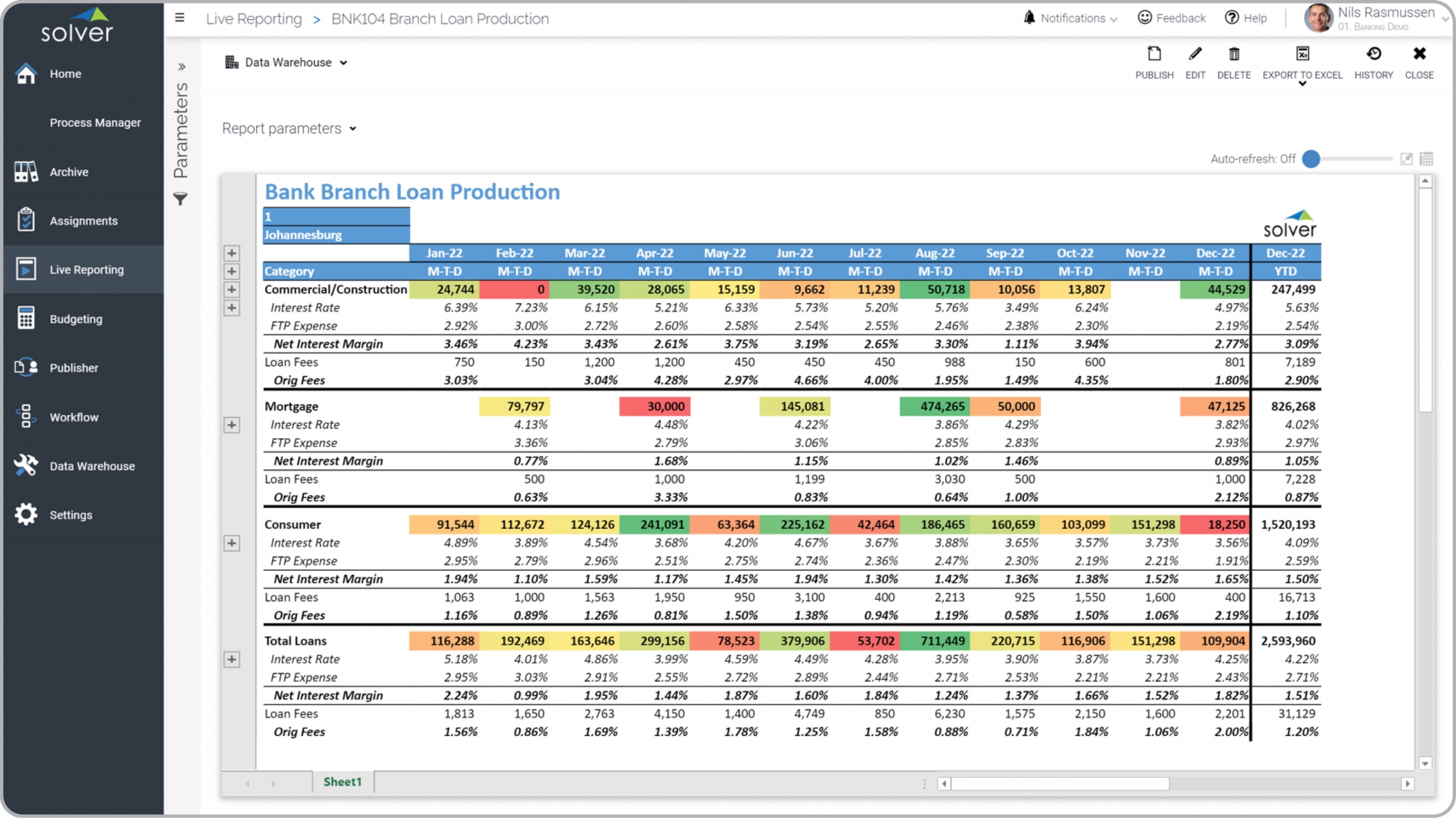Loan Production Trend Report for Banks
What is
a
Loan Production Trend Report for Banks
? Loan Production Trend Reports are considered operational analysis tools and are used by executives and loan managers to monitor trends and anomalies in branch-level and consolidated loan metrics. Some of the main functionality in this type of report is that it displays all the months of the year across the columns and loan metrics with totals down the rows. Key figures for each loan category are: Interest Rate, FTP Expense, Net Interest Margin, Loan Fees and Origination Fees. Examples of loan types in this report are: Commercial/Construction Loans, Mortgages, Consumer Loans, and Total for All Loans (not visible in the screenshot below). You find an example of this type of report below.
Purpose of
Loan Production Trend Reports Banks use Loan Production Trend Reports to give managers a clear picture of trends and anomalies in the loan portfolio of each branch. When used as part of good business practices in Loan- and Finance departments, a bank can improve its product offerings and profitability, and it can reduce the chances that decision-makers lack key monthly trend insights when they create or modify loan products and terms.
Example of a
Loan Production Trend Report Here is an example of a Loan Production Trend Report with key metrics per loan category. [caption id="" align="alignnone" width="2560"]
 Example of a Loan Production Trend Report for Banks[/caption] You can find hundreds of additional examples
here
Who Uses This Type of
Report
? The typical users of this type of report are: Executives, branch managers, loan managers, finance leaders, risk managers, analysts.
Other Reports Often Used in Conjunction with
Loan Production Trend Reports Progressive Loan- and Finance departments sometimes use several different Loan Production Trend Reports, along with detailed loan reports, loan portfolio dashboards, KPI dashboards, branch benchmarking reports, annual budgets, profit & loss trend reports, balance sheets and other management and control tools.
Where Does the Data for Analysis Originate From? The Actual (historical transactions) data typically comes from loan management systems and enterprise resource planning (ERP) systems like: Microsoft Dynamics 365 (D365) Finance, Microsoft Dynamics 365 Business Central (D365 BC), Microsoft Dynamics AX, Microsoft Dynamics NAV, Microsoft Dynamics GP, Microsoft Dynamics SL, Sage Intacct, Sage 100, Sage 300, Sage 500, Sage X3, SAP Business One, SAP ByDesign, Acumatica, Netsuite and others. In analyses where budgets or forecasts are used, the planning data most often originates from in-house Excel spreadsheet models or from professional corporate performance management (CPM/EPM) solutions.
What Tools are Typically used for Reporting, Planning and Dashboards? Examples of business software used with the data and ERPs mentioned above are:
Example of a Loan Production Trend Report for Banks[/caption] You can find hundreds of additional examples
here
Who Uses This Type of
Report
? The typical users of this type of report are: Executives, branch managers, loan managers, finance leaders, risk managers, analysts.
Other Reports Often Used in Conjunction with
Loan Production Trend Reports Progressive Loan- and Finance departments sometimes use several different Loan Production Trend Reports, along with detailed loan reports, loan portfolio dashboards, KPI dashboards, branch benchmarking reports, annual budgets, profit & loss trend reports, balance sheets and other management and control tools.
Where Does the Data for Analysis Originate From? The Actual (historical transactions) data typically comes from loan management systems and enterprise resource planning (ERP) systems like: Microsoft Dynamics 365 (D365) Finance, Microsoft Dynamics 365 Business Central (D365 BC), Microsoft Dynamics AX, Microsoft Dynamics NAV, Microsoft Dynamics GP, Microsoft Dynamics SL, Sage Intacct, Sage 100, Sage 300, Sage 500, Sage X3, SAP Business One, SAP ByDesign, Acumatica, Netsuite and others. In analyses where budgets or forecasts are used, the planning data most often originates from in-house Excel spreadsheet models or from professional corporate performance management (CPM/EPM) solutions.
What Tools are Typically used for Reporting, Planning and Dashboards? Examples of business software used with the data and ERPs mentioned above are:
- Native ERP report writers and query tools
- Spreadsheets (for example Microsoft Excel)
- Corporate Performance Management (CPM) tools (for example Solver)
- Dashboards (for example Microsoft Power BI and Tableau)
Corporate Performance Management (CPM) Cloud Solutions and More Examples
September 10, 2021
TAGS:
Reporting,
Solver,
report writer,
Microsoft,
template,
practice,
Acumatica,
Netsuite,
Finance,
monthly trend,
planning,
GP,
fintech,
Business Central,
excel,
ax,
forecast,
Budget,
Dynamics 365,
budgeting,
bank,
Cloud,
Software,
Tableau,
SAP,
example,
best,
Sage,
BC,
D365,
NAV,
Intacct,
financial institution,
CPM,
report,
branch,
SL,
Management,
dynamics,
Power BI,
mortgage,
interest,
loan production,
commercial,
loan sales,
loan

